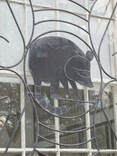The origins of Amesville
In 1797, Ephraim Cutler made his home in Ames Township. Other families followed, including George Ewing and his son Thomas, who was in the first graduating class from Ohio University. Sylvanus Ames settled in the area around 1800; he became the second sheriff of Athens County, a trustee of Ohio University, and representative to the 16th and 17th General Assemblies. At the time, these pioneer settlers didn't realize the impact they would make on the future town of Amesville.
The Coonskin Library, the most historic of Amesville’s institutions, opened its doors on February 2, 1804. Its official name was the Western Library Association. Most people referred to it as the Coonskin Library since raccoon furs provided the money necessary to begin the library. The library's holdings grew and included several hundred books by 1830. The Ohio Historical Society now holds most of the original volumes.
The Coonskin Library was not the first library in Ohio. At least two other libraries had been founded before Ohio became a state in 1803. Israel Putnam started a small library at Belpre in 1795. In 1802, Governor Arthur St. Clair and twenty-three other Cincinnati residents established the Cincinnati Library. To check out books at all three of these libraries, users had to be subscribers. This meant that they had to provide donations for the upkeep and the expansion of the libraries. They sometimes had to pay a yearly fee as well. These charges kept many Ohioans from being able to use these libraries.
Since 1797 Amesville has grown slowly but steadily. In 1802, the first school built in Ames Township was taught by Charles Cutler. The Amesville Academy was established after the town held a meeting about better education. The first Post Office was located in a brick building at the corner of State and Main Streets in 1821. At the time, the building was also home to a store. The United Methodist Church was formed in 1824, followed by the Amesville Presbyterian Church in 1829.
Unfortunately, the town's location on the bank of Federal Creek and by the McDougal Creek branch have made it prone to flooding. The first flood occurred in 1873. Many floods have followed, including back-to-back floods in 1997 and 1998. Each time, the community has come together to rebuild the town.
CHECK OUT THE AMESVILLE HISTORY WEBSITE: https://amesvillehistory.weebly.com/
Click on Sarah Cutler essay below to get more about the Coonskin Library or on the slide show, "A brief History of Amesville"
In 1797, Ephraim Cutler made his home in Ames Township. Other families followed, including George Ewing and his son Thomas, who was in the first graduating class from Ohio University. Sylvanus Ames settled in the area around 1800; he became the second sheriff of Athens County, a trustee of Ohio University, and representative to the 16th and 17th General Assemblies. At the time, these pioneer settlers didn't realize the impact they would make on the future town of Amesville.
The Coonskin Library, the most historic of Amesville’s institutions, opened its doors on February 2, 1804. Its official name was the Western Library Association. Most people referred to it as the Coonskin Library since raccoon furs provided the money necessary to begin the library. The library's holdings grew and included several hundred books by 1830. The Ohio Historical Society now holds most of the original volumes.
The Coonskin Library was not the first library in Ohio. At least two other libraries had been founded before Ohio became a state in 1803. Israel Putnam started a small library at Belpre in 1795. In 1802, Governor Arthur St. Clair and twenty-three other Cincinnati residents established the Cincinnati Library. To check out books at all three of these libraries, users had to be subscribers. This meant that they had to provide donations for the upkeep and the expansion of the libraries. They sometimes had to pay a yearly fee as well. These charges kept many Ohioans from being able to use these libraries.
Since 1797 Amesville has grown slowly but steadily. In 1802, the first school built in Ames Township was taught by Charles Cutler. The Amesville Academy was established after the town held a meeting about better education. The first Post Office was located in a brick building at the corner of State and Main Streets in 1821. At the time, the building was also home to a store. The United Methodist Church was formed in 1824, followed by the Amesville Presbyterian Church in 1829.
Unfortunately, the town's location on the bank of Federal Creek and by the McDougal Creek branch have made it prone to flooding. The first flood occurred in 1873. Many floods have followed, including back-to-back floods in 1997 and 1998. Each time, the community has come together to rebuild the town.
CHECK OUT THE AMESVILLE HISTORY WEBSITE: https://amesvillehistory.weebly.com/
Click on Sarah Cutler essay below to get more about the Coonskin Library or on the slide show, "A brief History of Amesville"
| sarahcutlerarticle.pdf | |
| File Size: | 72 kb |
| File Type: | |
| amesvillebriefhistory2015.pdf | |
| File Size: | 911 kb |
| File Type: | |

The Amesville History Center is now open during Coonskin Saturdays (third Saturday of each month starting at 5:00 pm). The Center is located behind the Amesville Elementary School west of Franklin Street. Follow the raccoon footprints up Franklin Street to your destination. Find more detailed information about the Coonskin Library at: https://amesvillehistory.weebly.com/history.html
The 1903 Story of Alonzo Weed who became Mayor of Amesville and leaped into national news. This story was recently reported by Tyler Buchanon in the Athens Messenger and is shown here in its complete version.
| alonzostory.pdf | |
| File Size: | 332 kb |
| File Type: | |
